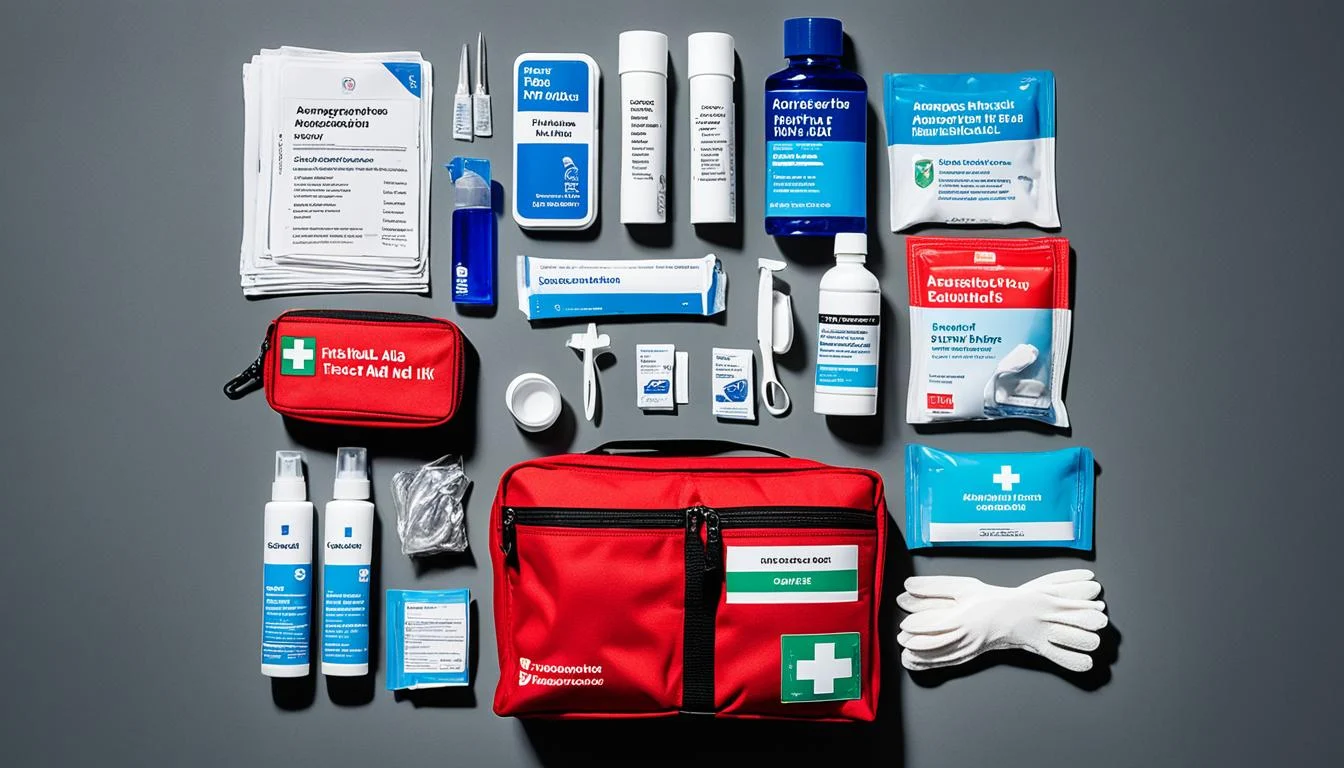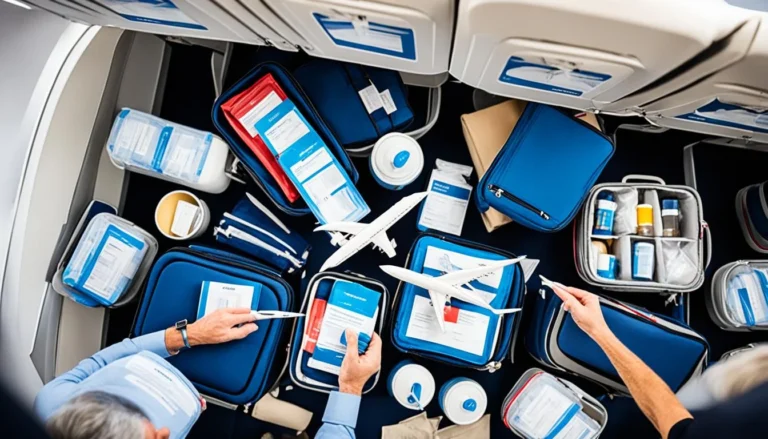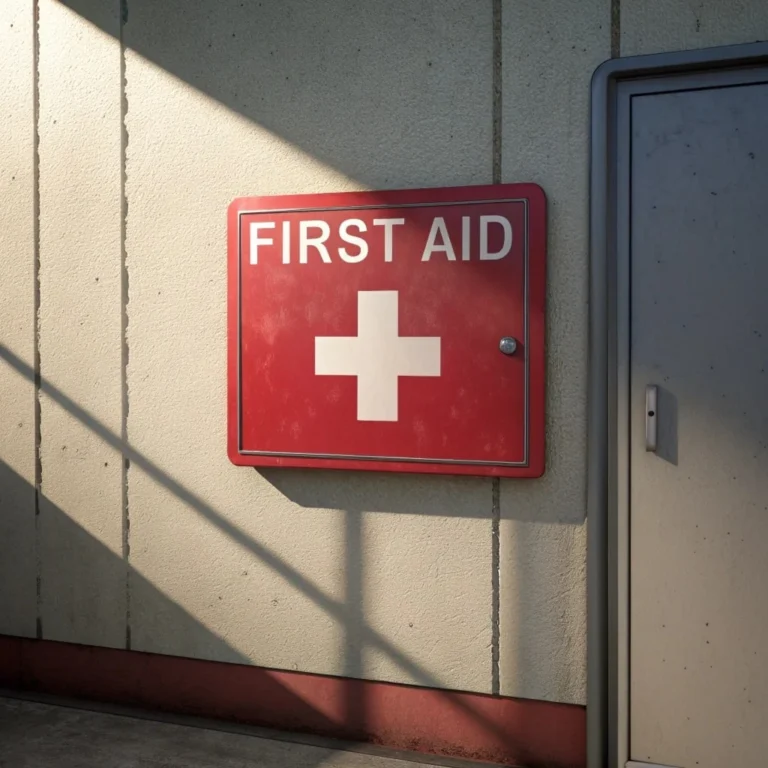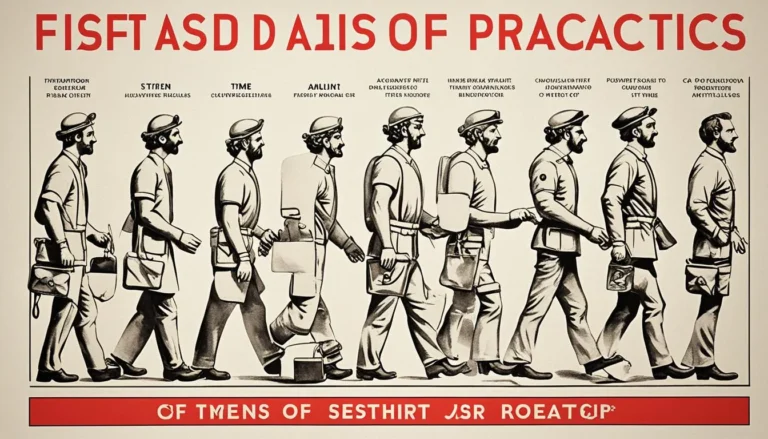Essential Workplace First Aid Kit Requirements
Why Workplace First Aid Kit Requirements is important?
Over 600,000 workers got hurt at work in Britain in a year. This shows how key safety and first aid are. Having the minimum requirements for workplace first aid kits can really help. It could be the difference between getting better quickly and having a major health issues. It’s crucial to have workplace first aid kit essentials close by. Also, following the UK’s health and safety rules is a must for businesses to run smoothly and keep staff safe.
Employers must make sure their work area is safe. They need to have the right first aid kits for any dangers that might be there. The Health and Safety Executive (HSE) says these kits should suit each workplace’s needs. This could be a building site or a quiet office. Having these kits is not just about following rules. It’s a key part of keeping the workplace safe.
Key Takeaways
- Understanding the importance of first aid kits in preventing workplace injuries.
- Recognising the link between legal compliance and first aid readiness.
- Ensuring first aid kits meet HSE’s recommended contents for different working environments.
- Adapting first aid supplies to the specific risks identified in an organisation’s needs assessment.
- Maintaining and updating first aid provisions to align with British Standard (BS) 8599 requirements.
Understanding the Importance of a Workplace First Aid Kit
Making sure workplace safety is taken seriously is vital. Having first aid supplies for the workplace ready can really help in an emergency. It can keep things from getting worse until professional help comes. This shows that stopping problems before they start is very important for a safe work place.
The role of a first aid kit in workplace safety
A first aid kit at work is very important. It can lower the chance of small injuries getting big. These kits help with small hurts and make getting better from big ones easier. This shows that bosses care about their workers’ health.
Legal implications of inadequate first aid provisions
There are laws, like OSHA first aid kit requirements, that say work places must have first aid kits. These rules prove being ready is key. Not following them can be bad for both staff and businesses. It could lead to legal problems and fines.
So, having a good first aid kit shows a company cares about its team. It also means following the law and keeping a safe work place.
Comprehensive Guidelines for Minimum Requirements for Workplace First Aid Kits
In the UK, bosses must keep their workers safe. It’s vital to meet the minimum requirements for workplace first aid kits. This is not just about following rules. It helps to keep everyone at work safe and well. Employers need to check what their workplace needs. They must think about how many people work there, the kind of work they do, and how the workplace is set up.
The HSE says every workplace needs a good first aid kit. What’s in the kit depends on what the workplace needs. But there are some basic items that should be in every kit:
- A leaflet with general first aid information
- Medium and large sterile gauze dressings
- At least a couple of eye pads
- Triangular bandages for immobilising limbs or as wound dressings
- Safety pins for securing bandages
- Disposable gloves for hygiene protection
- Alcohol-free cleansing wipes for cleaning the skin around the wound
It’s also key to regularly check the first aid kit. Make sure everything is up to date and replace things that have been used. Some workplaces might need extra items due to special dangers.
| Item | Basic Kit | For hazardous environments |
|---|---|---|
| Sterile plasters | Yes | Yes |
| Wound dressings | Medium and large | Multiple sizes + specialised types |
| Burn dressings | Optional | Yes |
| Eye wash | No | Yes |
| Resuscitation face shield or mask | Yes | Yes |
| Tourniquet | No | Yes, if at risk of major bleeding |
| Defibrillator | Advised | Strongly advised |
Employers should think carefully about their first aid kits. It’s about following the law and meeting real needs. If something goes wrong, having the right first aid supplies can save a life or reduce the harm of an injury.
Assessing Your Workplace’s First Aid Needs
Every workplace should start with conducting a first aid needs assessment. It’s crucial to know the hazards that can happen at work. This helps create a personal workplace first aid kit checklist. Being prepared means you can handle emergencies well.
Conducting a first aid needs assessment
First aid needs assessment means looking at all workplace dangers. You consider what injuries might happen and how big accidents could be. It requires knowing your work area well to get first aid right.
Identifying specific risks and tailor requirements
After spotting risks, make the first aid kit right for your workplace. You might add more items or special things like burn dressings or eyewash. This way, you’re ready for anything.
- Assess the environment for risks particular to your industry.
- Include first aid supplies that match the identified risks.
- Ensure enough quantities to cover the workforce and the operation time.
- Regularly review and update the checklist in line with dynamic workplace conditions.
Essential Contents for Low-Risk Workplaces
When talking about low-risk workplace first aid essentials, we think of office jobs. Here, it’s key to have items for minor injuries. These basics form the workplace first aid kit contents for safer areas.
Basic components of a first aid kit for desk jobs
Even in low-risk places, keeping a first aid kit right is crucial. The kit should have items for common office accidents. Here’s what every safe workplace’s first aid kit needs:
- First aid guidance leaflet – It gives easy step-by-step injury care.
- Sterile plasters of different sizes – For small cuts.
- Sterile eye pads – Very needed for eye injuries, even in safe spots.
- Triangular bandages – Great for holding limbs or making slings.
- Safety pins – They keep bandages tied up.
- Sterile wound dressings – They stop infections right away.
- Disposable gloves – They keep illnesses from spreading.
We must check that all workplace first aid kit contents are not out of date. Making sure the kit is up-to-date and cleverly stocked is critical in a low-risk workplace.
It’s not just about having a first aid kit. Regularly checking its items is a must to ensure everything works. Keeping records of these checks keeps the kit ready always. Doing so means even the safest places can handle health and safety well.
Beyond Basics: Additional First Aid Supplies for Workplace
Workplaces should have more than basic first aid kit items. This is to meet OSHA first aid kit requirements. It also keeps everyone safe in different situations. Adding more supplies shows care for employee safety and legal rules.
Creating a safe work culture means regularly updating the first aid kit. This includes adding new items as needed. It shows employees that their health is important.
Now, let’s talk about some extra supplies for a better workplace first aid kit:
high-risk environments
These items can make a big difference in emergencies. An up-to-date workplace first aid kit inventory shows a business cares about health ahead of just following rules.
| Additional Supply | Relevance | Usage Application |
|---|---|---|
| Burn Dressings | Workplaces with potential thermal exposure (e.g. kitchens, engineering workshops) | Immediate application to burn injuries to cool the area and prevent further tissue damage |
| Splints | Environments with potential for musculoskeletal injuries | Immobilisation of injured limbs awaiting professional medical attention |
| Poison Treatment Packs | Workplaces handling chemicals or hazardous substances | Rapid response to ingestion or exposure to harmful agents |
| Bloodborne Pathogen Kits | Any workplace, given the universal risk of accidents involving blood | Safe clean-up and disposal of materials contaminated with blood or other bodily fluids |
| AED | High-traffic and high-risk areas for sudden cardiac arrest | Emergency defibrillation pre-hospital arrival for suspected cardiac arrest cases |
Going beyond OSHA first aid kit requirements makes a big difference. Investing in full first aid preparation can save lives. It’s very beneficial for all organisations.
High-Risk Environments: Specialised First Aid Kit Additions
In places where dangers are everyday, having specialised first aid supplies is crucial. Workplaces like kitchens, factories, and labs face unique risks. They need more than just basic first aid gear.
Catering to potential burns and cuts in restaurants
Catering first aid kits are made for the accidents chefs and kitchen staff might have. They deal with hot stuff, boiling liquids, and sharp things. So, it’s important to have burns first aid things ready. Things like burn relief gels, dressings, and special plasters are key for any kitchen first aid box.
Eyecare necessities for factories and laboratories
Factories and labs need eyecare first aid because of chemicals and tiny particles. They need to have things like eyewash stations or pods and sterile eye dressings. These help wash out bad stuff from the eyes to stop harm. It’s also key to teach staff how to use these items right when needed.
Selecting a Compliant Workplace First Aid Kit
When choosing health and safety gear for work, pick an HSE-approved first aid kit right for the job. Make sure it follows the latest rules. It’s not only about following rules but also about being ready for emergencies.
What to look for in an HSE-approved kit
Looking for the right first aid kit compliance means finding kits that match HSE advice. These kits often come with a British Standard BS 8599 seal. This seal means they are good and complete. Here’s a list of what a good HSE-approved first aid kit should have:
- Guidance leaflet providing first aid information
- Medium and large sterile dressings
- Adhesive plasters suitable for various skin types
- Sterile wound dressings and bandages
- Triangular bandages for immobilising injuries
- Safety pins and adhesive tape
- Sterile eye pads for eye injury coverage
- Disposable gloves for hygiene and protection
- Resuscitation face shield for safe CPR
Make sure the kit fits what your workplace needs. While standard kits are a start, they might not cover every risk in your place.
| Item | Quantity for Small Kit | Quantity for Medium Kit | Quantity for Large Kit |
|---|---|---|---|
| Guidance Leaflet | 1 | 1 | 1 |
| Medium Sterile Dressings | 4 | 6 | 8 |
| Large Sterile Dressings | 1 | 2 | 2 |
| Adhesive Plasters | 40 | 60 | 100 |
| Sterile Eye Pads | 2 | 3 | 4 |
| Triangular Bandages | 2 | 3 | 4 |
Being ready is key for first aid kit compliance. By choosing a kit with the HSE’s OK, you’re looking out for your team and your business. Keep informed, be ready, and value health and safety at work.
Workplace First Aid Kit Regulations and British Standards
Every UK employer must know about workplace first aid kit regulations and follow BS 8599. Having the right first aid kit shows you care about safety. It’s also the law.
Adhering to BS 8599 requirements
Employers need to learn about BS 8599 to keep workplaces safe. These rules help decide what and how much should be in first aid kits. Different workplaces need different kits.
| BS 8599-1 Kit Contents | Small Kit | Medium Kit | Large Kit |
|---|---|---|---|
| Sterile Plasters | 40 | 60 | 100 |
| Dressings, various sizes | 4 | 6 | 8 |
| Eye Pads | 2 | 3 | 4 |
| Triangular Bandages | 2 | 3 | 4 |
| Safety Pins | 12 | 12 | 24 |
| Disposable Gloves (Pairs) | 6 | 9 | 12 |
| Resuscitation Face Shield | 1 | 1 | 2 |
| Burn Dressings | 1 | 2 | 2 |
Employers must follow these guidelines to help injured workers quickly. Staying updated with workplace first aid kit regulations is vital. This shows care for employee safety and security.
Workplace First Aid Kit Checklist: A Comprehensive Inventory
Keeping a full workplace first aid kit is key. It’s not just a legal thing. It’s about making sure everyone is safe. A workplace first aid kit checklist helps a lot with this. It’s a simple way to keep track of items, when they’re used, and when they expire. It’s the heart of a good first aid plan. This makes sure you have everything you need when you need it.
A good checklist covers it all. From plasters to tourniquets, and eye wash to warm blankets. It’s important to check this list often. This means you’re always ready for emergencies. Being ready can save time when every second matters. It also helps employers avoid legal troubles. Plus, it makes the workplace safer for everyone.
To make and keep the checklist updated, you need to know the risks at work. And the injuries that might happen. For anyone in charge of safety, the workplace first aid kit checklist is a guide and a record. Keeping this checklist updated is vital. It keeps everyone safe at work and gives peace of mind to both bosses and workers.







